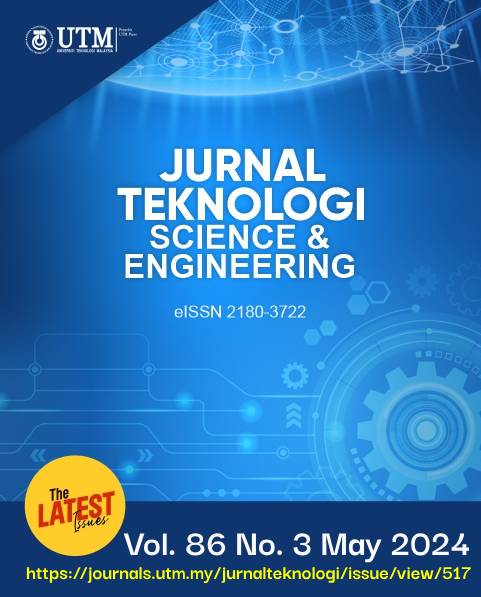THE EFFECT OF SAWDUST AS SELF-CURING AGENT IN CONCRETE
DOI:
https://doi.org/10.11113/jurnalteknologi.v86.20946Keywords:
Curing agent, water retention capacity, sawdust, internal curing, curing regimesAbstract
Concrete is known as the most used material for the construction industry. It is crucial to understand the properties of concrete especially on curing interaction and process. At the water shortage areas, the production of concrete is limited as approximately 230 liters of water is needed for 1 m3 of concrete. The insufficient of water resources has inhibited the building construction and development. Nowadays, researchers have studied and developed curing technology by implementing curing agents into concrete mixes. In this paper, the potential and properties of pre-wetted sawdust as curing agent is investigated and studied. Different curing regimes are implemented and tested to determine the properties of sawdust as curing agent. The results showed that the sawdust has potential to be used for curing agent as the concrete properties have been enhanced with strength index ratios ranging between 0.87 until 0.98. Moreover, the compressive strength and tensile properties were also developed with range ratios between 0.69 up until 0.98, respectively. Hence, the application of pre-wetted sawdust inside concrete is effective for concrete production and highly recommended to be implemented at the water shortage areas.
References
Ma, C. K., Sulaiman, M. F., Apandi, N., Awang, A. Z., Omar, W. and Jaw, S. W. 2019. Ductility and Stiffness of Slender Confined Reinforced High-strength Concrete Columns Under Monotonic Axial Load. Measurement. 146: 838-845.
Jumaat, M. Z., Kabir, M. H. and Obaydullah, M. 2006. A Review of the Repair of Reinforced Concrete Beams. Journal of Applied Science Research. 2(6): 317-326.
Ong, C. B., Chin, C. L., Ma, C. K., Tan, J. Y., Awang, A. Z. and Omar, W. 2022. Seismic Retrofit of Reinforced Concrete Beam-column Joints using Various Confinement Techniques: A Review. Structures. 42: 221-243.
Memon, R. P., Mohd, A. R. B., Awang, A. Z., Huseien, G. F. and Memon, U. 2018. A Review: Mechanism, Materials and Properties of Self-curing Concrete. ARPN J. Eng. Appl. Sci. 13: 9304-9397.
Memon, R. P., Sam, A. R. M., Awang, A. Z. and Memon, U. I. 2018. Effect of Improper Curing on the Properties of Normal Strength Concrete. Engineering, Technology & Applied Science Research. 8(6).
Tan, J. Y., Chin, C. L., Ma, C. K., Ong, C. B., Awang, A. Z., Omar, W. and Lam, S. K. 2023. Pre-Tensioned Steel Straps for Seismic Retrofit of Reinforced Concrete Columns under Combined Loading of Flexure, Shear and Torsion. Structures. 56: 104935.
Lee, H. P., Awang, A. Z. and Omar, W. 2014. Strength and Ductility of High-strength Concrete Cylinders Externally Confined with Steel Strapping Tensioning Technique (SSTT). Jurnal Teknologi. 68(1): 11.
Sulaiman, M. F., Chin, C. L., Ma, C. K., Awang, A. Z. and Omar, W. 2022. Pullout Behaviour of Bars in Concrete Confined with Post-tensioned Steel Straps. International Journal of Civil Engineering. 1-12.
Memon, R. P., Huseien, G. F., Saleh, A. T., K. Ghoshal, S., Memon, U., Alwetaishi, M., Benjeddou, O. and Sam, A. R. M. 2022. Microstructure and Strength Properties of Sustainable Concrete Using Effective Microorganisms as a Self-Curing Agent. Sustainability. 14(16): 10443.
Memon, R. P., Sam, A. R. M., Awang, A. Z., Tahir, M. M., Mohamed, A., Kassim, K. A. and Ismail, A. 2020. Introducing Effective Microorganism as Self-curing Agent in Self-cured Concrete. IOP Conference Series: Materials Science and Engineering. 849(1): 012081.
Memon, R. P., Sam, A. R. M., Awang, A. Z. and Memon, U. I. 2018. Effect of Improper Curing on the Properties of Normal Strength Concrete. Engineering, Technology & Applied Science Research. 8(6).
Memon, R. P., Sam, A. R. M., Awal, A. A. and Achekzai, L., 2017. Mechanical and Thermal Properties of Sawdust Concrete. Jurnal Teknologi. 79(6): 23-27.
Memon, R. P., Achekzai, L., Abdul, A. R., Awal, A. A. and Memon, U. 2018. Performance of Sawdust Concrete at Elevated Temperature. J. Teknol. 80(1): 165-171.
Hamzah, N., Mohd Saman, H., Baghban, M. H., Mohd Sam, A. R., Faridmehr, I., Muhd Sidek, M. N., Benjeddou, O. and Huseien, G. F. 2022. A Review on the Use of Self-curing Agents and Its Mechanism in High-performance Cementitious Materials. Buildings. 12(2): 152.
Kumar, M. J., Srikanth, M. and Rao, K. J. 2012. Strength Characteristics of Self-curing Concrete. International Journal of Research in Engineering and Technology (IJRET). 1(1): 51-57.
Huseien, G. F., Shah, K. W. and Sam, A. R. M. 2019. Sustainability of Nanomaterials based Self-healing Concrete: An All-inclusive Insight. Journal of Building Engineering. 23: 155-171.
Hamzah, N., Mohd Saman, H., Baghban, M. H., Mohd Sam, A. R., Faridmehr, I., Muhd Sidek, M. N., Benjeddou, O. and Huseien, G. F. 2022. A Review on the Use of Self-curing Agents and Its Mechanism in High-performance Cementitious Materials. Buildings. 12: 152.
Mousa, M. I., Mahdy, M. G., Abdel-Reheem, A. H. and Yehia, A. Z. 2015. Mechanical Properties of Self-curing Concrete (SCUC). HBRC Journal. 11(3): 311-320.
Beibei Sun, Hao Wu, Weimin Song, Zhe Li, Jia Yu. 2019. Design Methodology and Mechanical Properties of Superabsorbent Polymer (SAP) Cement-based Materials. Construction and Building Materials. 204: 440-449.
Reddy, M. and Praveen, R. 2019. Effect of Polyethylene Glycol in Self-Curing of Self-compacting Concrete. Int. J. Recent Technol. Eng. (IJERT). 8: 7280-7283.
Zhang, C., Pang, C., Mao, Y. and Tang, Z. 2022. Effect and Mechanism of Polyethylene Glycol (PEG) Used as a Phase Change Composite on Cement Paste. Materials. 15(8): 2749.
Downloads
Published
Issue
Section
License
Copyright of articles that appear in Jurnal Teknologi belongs exclusively to Penerbit Universiti Teknologi Malaysia (Penerbit UTM Press). This copyright covers the rights to reproduce the article, including reprints, electronic reproductions, or any other reproductions of similar nature.
















